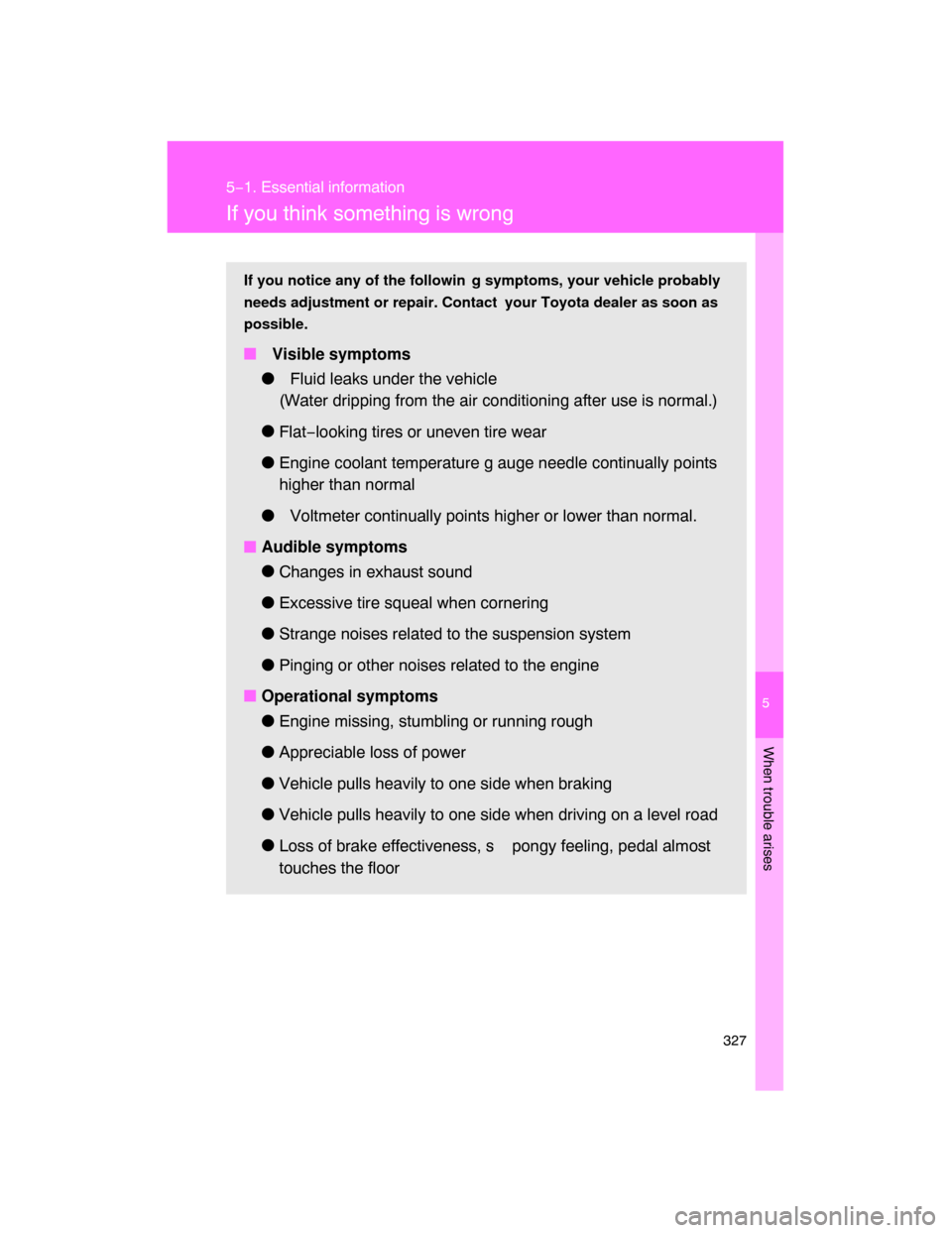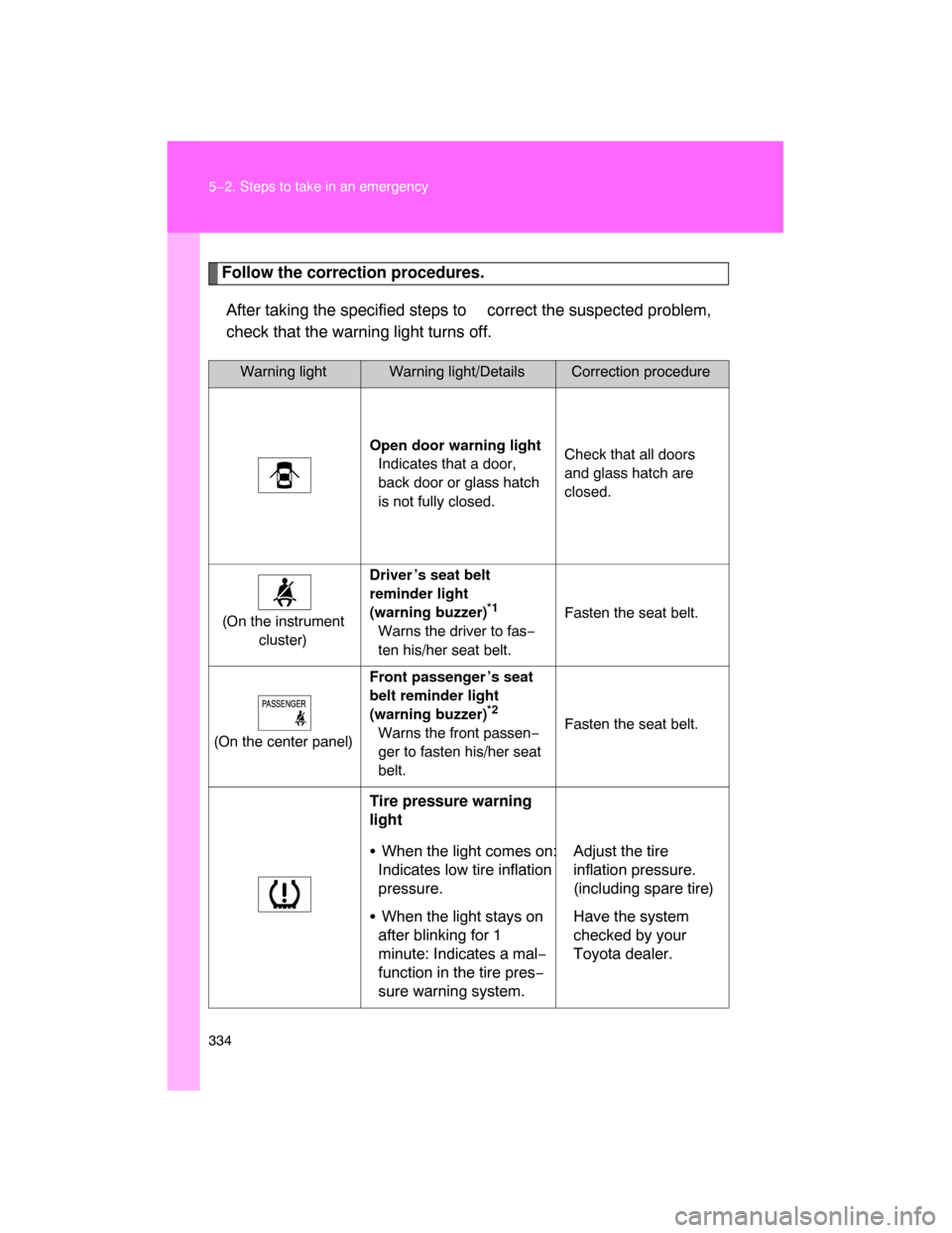Page 292 of 400

296
4−3. Do−it−yourself maintenance
Wheels
�When replacing wheels
The wheels of your Toyota are equipped with sensors that allow the tire
pressure warning system sensors to provide advanced warning in the
event of a loss in tire inflation pressure. Whenever wheels are replaced,
the tire pressure warning valve and transmitter must be switched over
from the old wheels. (
P. 288) If a wheel is bent, cracked or heavily corroded, it should be
replaced.
Otherwise, the tire may separate from the wheel or cause loss of
handling control.
� Wheel selection
When replacing wheels, care should be taken to ensure that
they are equivalent to those removed in load capacity, diameter,
rim width, and offset.
Replacement wheels are available at your Toyota dealer.
Toyota does not recommend using:
�
Wheels of different sizes or types
�Used wheels
�
Bent wheels that have been straightened
�
Aluminum wheel precautions (if equipped)
�Use only Toyota wheel nuts and wrench designed for use with
your aluminum wheels.
� When rotating, repairing or changing your tires, check that the
wheel nuts are still tight after driving 1000 miles (1600 km).
�
Be careful not to damage the aluminum wheels when using
tire chains.
� Use only Toyota genuine balance weights or equivalent and a
plastic or rubber hammer when balancing your wheels.
Page 322 of 400

5
When trouble arises
327
5−1. Essential information
If you think something is wrong
If you notice any of the followin g symptoms, your vehicle probably
needs adjustment or repair. Contact your Toyota dealer as soon as
possible.
� Visible symptoms
� Fluid leaks under the vehicle
(Water dripping from the air conditioning after use is normal.)
�
Flat−looking tires or uneven tire wear
�Engine coolant temperature g auge needle continually points
higher than normal
� Voltmeter continually points higher or lower than normal.
�Audible symptoms
�
Changes in exhaust sound
�
Excessive tire squeal when cornering
�Strange noises related to the suspension system
�
Pinging or other noises related to the engine
�
Operational symptoms
�Engine missing, stumbling or running rough
�
Appreciable loss of power
�
Vehicle pulls heavily to one side when braking
�Vehicle pulls heavily to one side when driving on a level road
�
Loss of brake effectiveness, s pongy feeling, pedal almost
touches the floor
Page 329 of 400

334 5−2. Steps to take in an emergency
Follow the correction procedures.
After taking the specified steps to correct the suspected problem,
check that the warning light turns off.
Warning lightWarning light/Details Correction procedure
Open door warning light
Indicates that a door,
back door or glass hatch
is not fully closed.Check that all doors
and glass hatch are
closed.
(On the instrument
cluster)Driver ’s seat belt
reminder light
(warning buzzer)
*1
Warns the driver to fas−
ten his/her seat belt.Fasten the seat belt.
(On the center panel)Front passenger ’s seat
belt reminder light
(warning buzzer)
*2
Warns the front passen−
ger to fasten his/her seat
belt.Fasten the seat belt.
Tire pressure warning
light
�When the light comes on:
Indicates low tire inflation
pressure.Adjust the tire
inflation pressure.
(including spare tire)
�When the light stays on
after blinking for 1
minute: Indicates a mal−
function in the tire pres−
sure warning system.
Have the system
checked by your
Toyota dealer.
Page 331 of 400

336 5−2. Steps to take in an emergency
� Key reminder buzzer
The buzzer indicates that the key has not been removed (with the engine
switch in the ACC or LOCK position and the driver ’s door opened).
� If the malfunction indicator lamp comes on while driving
First check the following:
�Is your vehicle low on gas?
If it is, refuel the vehicle immediately.
� Is the fuel tank cap loose?
If it is, tighten it securely.
The light will go off after taking several driving trips.
If the light does not go off even after several trips, contact your Toyota dealer
as soon as possible.
� Front passenger detection sensor and passenger seat belt reminder
If luggage or other load is placed on the front passenger seat, depending on
its weight, the reminder light to flash and buzzer to sound.
�
When the tire pressure warning light comes on
Check the tire inflation pressure and adjust to the appropriate level.
�The tire pressure warning light may turn on due to natural causes
The tire pressure warning light may turn on due to natural causes such
as natural air leaks or tire inflation pressure changes caused by temper−
ature. In this case, adjusting the ti
re inflation pressu re will turn off the
warning light after a few minutes.
�When a tire is replaced with a spare tire
The spare tire is also equipped with the tire pressure warning valve and
transmitter. The tire pressu
re warning light will turn on if the tire inflation
pressure of the spare tire is low. If a tire goes flat, even though the flat
tire is replaced with the spare tire, the warning light does not turn off.
Replace the spare tire with the repair
ed tire and adjust the proper tire
inflation pressure. The ti re pressure warn ing light will turn off after a few
minutes.
Page 332 of 400

5
When trouble arises
337 5−2. Steps to take in an emergency
�If the tire pressure warning system is inoperative
The tire pressure warning system may become inoperative in the follow−
ing conditions:
(When the condition be
comes normal, the system will work properly.)
�If tires not equipped with tire pressure warning valves and transmit−
ters are used.
�If the ID code on the tire pressure warning valves and transmitters is
not registered in the tire pressure warning computer.
�If electronic devices or facilities us ing similar radio wave frequencies
are nearby.
�If a radio set at similar frequencies is in use in the vehicle.
�If a window tint that affects the radio wave signals is installed.
�If there is a lot of snow or ice on the vehicle, in particular around the
wheels or wheel housings.
�If non−genuine Toyota wheels are used.
�If tire chains are used.
�If the spare tire is in a location subject to poor radio wave signal
reception.
�If the tire inflation pressure is more than 73 psi (500 kPa, 5.1 kgf/cm2
or bar) or higher.
�If the tire pressure warning light comes on after blinking for 1
minute frequently
If the tire pressure warning light comes on after blinking for 1 minute fre−
quently when the engine switch is
turned to the ON position, have it
checked by your Toyota dealer.
� After changing the engine oil (U.S.A. only)
Make sure to reset the oil maintenance data. ( P. 278)
� Customization that can be configured at Toyota dealer
The vehicle speed linked seat belt reminder buzzer can be disabled.
(Customizable features
P. 386)
Page 333 of 400

338 5−2. Steps to take in an emergency
CAUTION
�Maintenance of the tire
Each tire, including the spare (if provided), should be checked monthly
when cold and inflated to the inflation pressure recommended by the
vehicle manufacturer on the vehicle
placard or tire inflation pressure
label (tire and load information label). (If your vehicle has tires of a differ−
ent size than the size indicated on the vehicle placard or tire inflation
pressure label [tire and load information label], you should determine the
proper tire inflation pr
essure for those tires.)
As an added safety feature, your
vehicle has been equipped with a tire
pressure monitoring system (TPMS−ti re pressure warning system) that
illuminates a low tire pressure telltal e (tire pressure warning light) when
one or more of your tires is significantly under−inflated. Accordingly,
when the low tire pressu
re telltale (tire pressure warning light) illumi−
nates, you should stop and check your tires as soon as possible, and
inflate them to the proper pressure. Driving on a significantly under−
inflated tire causes the tire to overheat and can lead to tire failure.
Under−inflation also reduces fuel effi
ciency and tire tread life, and may
affect the vehicle’s handling and stopping ability.
Please note that the TPMS (tire pressure warning system) is not a sub−
stitute for proper tire main tenance, and it is the driver ’s responsibility to
maintain correct tire pressure, even if under−inflation has not reached the
level to trigger illu
mination of the TPMS low ti re pressure telltale (tire
pressure warning light).
Your vehicle has also been equipped with a TPMS (tire pressure warning
system) malfunction indicator to indi cate when the system is not operat−
ing properly. The TPMS (tire pressure warning system) malfunction indi−
cator is combined with the low tire pressure telltale (tire pressure
warning light). When the system det
ects a malfunction, the telltale will
flash for approximately one minute an d then remain continuously illumi−
nated. This sequence will
continue upon subsequent vehicle start−ups as
long as the malfunction exists. When the malfunction indi cator is illumi−
nated, the system may not be able to detect or signal low tire pressure
as intended.
Page 334 of 400

5
When trouble arises
339 5−2. Steps to take in an emergency
CAUTION
TPMS (tire pressure warning system ) malfunction may occur for a vari−
ety of reasons, including the installati
on of replacement or alternate tires
or wheels on the vehicle that prevent the TPMS (tire pressure warning
system) from functioning properly. Always check the TPMS (tire pres−
sure warning system) malfunction te
lltale after replacing one or more
tires or wheels on your vehicle to ensure that the replacement or alter−
nate tires and wheels allow the TPMS (tire pressure warning system) to
continue to function properly.
�If the tire pressure warning light comes on
Be sure to observe the following precautions. Failure to do so could
cause loss of vehicle control and result in death or serious injury.
�Stop your vehicle in a safe place as
soon as possible. Adjust the tire
inflation pressure immediately.
�If the tire pressure warning light comes on even after tire inflation pres−
sure adjustment, it is probable that you have a flat tire. Check the tires.
If the tire is flat, change to the spare tire and have the flat tire repaired
by the nearest Toyota dealer.
�Avoid abrupt maneuvering and braking. If the vehicle tires deteriorate,
you could lose control of the steering wheel or the brakes.
�If a blowout or sudden air leakage should occur
The tire pressure warning system may not activate immediately.
NOTICE
�Precaution when installing a different tire
When a tire of a different specification or maker is installed, the tire pres−
sure warning system may
not operate properly.
Page 335 of 400
340
5−2. Steps to take in an emergency
If you have a flat tire
Remove the flat tire and replace it with the spare provided.
� Before jacking up the vehicle
� Stop the vehicle on a hard, flat surface.
�Set the parking brake.
�
Shift the shift lever to P (automatic transmission) or R (manual
transmission).
� Stop the engine.
�Turn on the emergency flashers.
�
Location of the spare tire, jack and tools
Tool bag
Spare tire
Jack